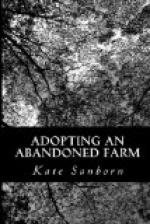“Sandy,” the handsome setter, loathed the pug, and tried to bite his neck in a fatal way. He also chased the rabbits, trod on young turkeys so that they were no more, drove the cat out of the barn and up a tree, barked madly at the cows, enraging those placid animals, and doted on frightening the horse.
The cat allowed mice to roam merrily through the grain bins, preferring robins and sparrows, especially young and happy mothers, to a proper diet; was fond of watching the chickens with wicked, malicious, greedy, dangerous eyes, and was always ready to make a sly spring for my canaries.
The rabbits (pretty innocent little creatures I had thought them, as I gazed at their representatives of white canton flannel, solidly stuffed, with such charming eyes of pink beads) girded all my young trees and killed them before I dreamed of such mischief, nibbled at every tender sprout, every swelling bud, were so agile that they could not be captured, and became such a maddening nuisance that I hired a boy to take them away. I fully understand the recent excitement of the Australians over the rabbit scourge which threatened to devastate their land.
The relations were strained between my cows; mother and daughter of a noble line; they always fed at opposite corners of the field, indulging in serious fights when they met.
My doves! I am almost ready to say that they were more annoying than all the rest of my motley collection, picked all seeds out of the ground faster than they could be put in, so large spaces sowed with rye lay bare all summer, and ate most of the corn and grain that was intended to fatten and stimulate my fowls.
Doves are poetical and pleasing, pigeons ditto—in literature, and at a safe distance from one’s own barn. It’s a pretty sight at sunset on a summer’s eve to see them poising, wheeling, swirling, round a neighbor’s barn. Their rainbow hues gleam brightly in the sun as they preen their feathers or gently “coo-oo, I love oo,” on the ridge pole. I always longed to own some, but now the illusion is past. They have been admired and petted for ages, consecrated as emblems of innocence and peace and sanctity, regarded as almost sacred from the earliest antiquity. They have been idealized and praised from Noah to Anacreon, both inclined to inebriety! But in reality they are a dirty, destructive, greedy lot, and though fanciers sell them at high prices, they only command twenty-five cents per pair when sold for the market!
The hens lost half their feathers, often an eye, occasionally a life, in deadly feuds. My spunky little bantam game cock was always challenging one of my monster roosters and laying him low, so he had to be sent away.
John, my eccentric assistant, could abide no possible rival, insulted every man engaged to help him, occasionally indulging in a free fight after too frequent visits to the cider barrels of my next neighbor, so he had to follow the bantam.




